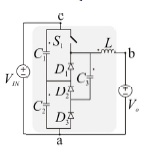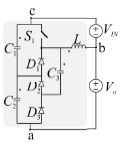- ALL COMPUTER, ELECTRONICS AND MECHANICAL COURSES AVAILABLE…. PROJECT GUIDANCE SINCE 2004. FOR FURTHER DETAILS CALL 9443117328


Projects > ELECTRICAL > 2017 > IEEE > POWER ELECTRONICS
This paper presents a hybrid non-isolated dc-dc commutation cell, which is generated by the integration between conventional commutation cell and ladder-type passive switched capacitor cell. From the resulted hybrid cell are derived three different dc-dc converters: a buck type, a boost-type and a buck-boost-type. The three structures are analyzed in this paper and are presented the topological stages, static gain characteristics in CCM and DCM, steady-state analysis. The analyses are generalized in relation to the number of switched-capacitor cells employed, which allows the increase of the rated gain of the converters by adding more switched capacitor cells. In addition, the proposed hybrid non-isolated dc-dc commutation divides naturally the voltage stress among the semiconductors and capacitors of the power stage.
Hybrid Switched-Inductor Converters, Modular Single-Switch Flyback Converter.
The new hybrid dc-dc commutation cell proposed in this paper integrates a passive switched-capacitor cell with the conventional commutation cell. The three converters generated from the commutation cell are referred to as the hybrid dc-dc buck, hybrid dc-dc boost and hybrid dc-dc buck-boost converters. On applying the commutation cell concept was possible to analyze the three derived converters together. As approached in this paper, the proposed hybrid commutation cell was generalized for any number of SC cells in series-connection (ladder configuration). Thus, different gain rated for the proposed hybrid buck, boost and buck-boost converters can be ascertained. As results, the generalized structures were also defined in this paper. The main advantages of proposed topologies are the wide range of gains and reduced voltage stress on the components in comparison with the conventional dc-dc converters (for the same duty cycle). Furthermore, the voltage stresses are equally divided among the semiconductors and capacitors of the power stage, thus no capacitors voltages balance control are need and the strategies of the control applied in conventional converters can be used to proposed converters.
The three converters generated for the hybrid commutation cell - Hybrid dc-dc buck type converter

Hybrid dc-dc boost type converter

Hybrid dc-dc buck-buck type converter
